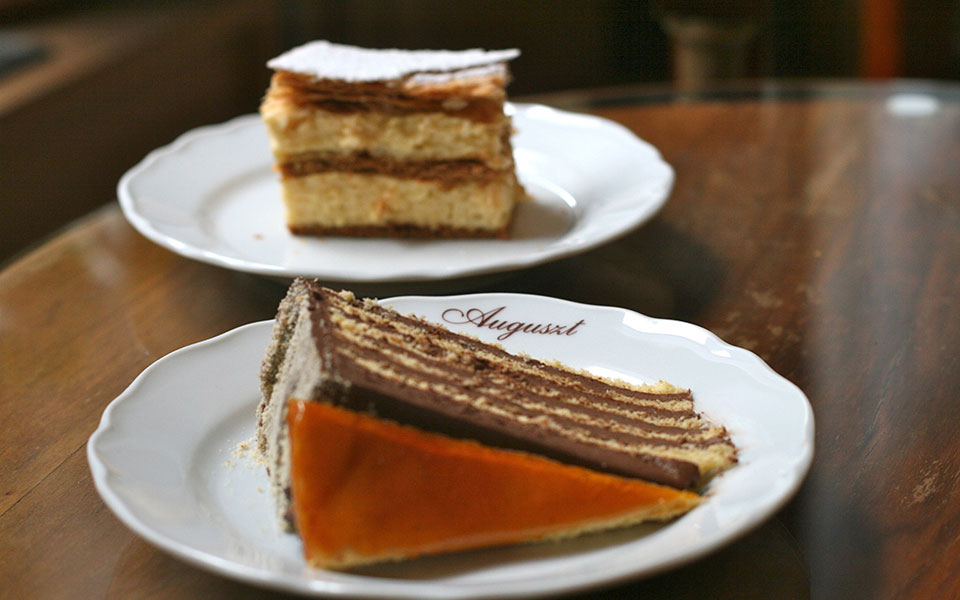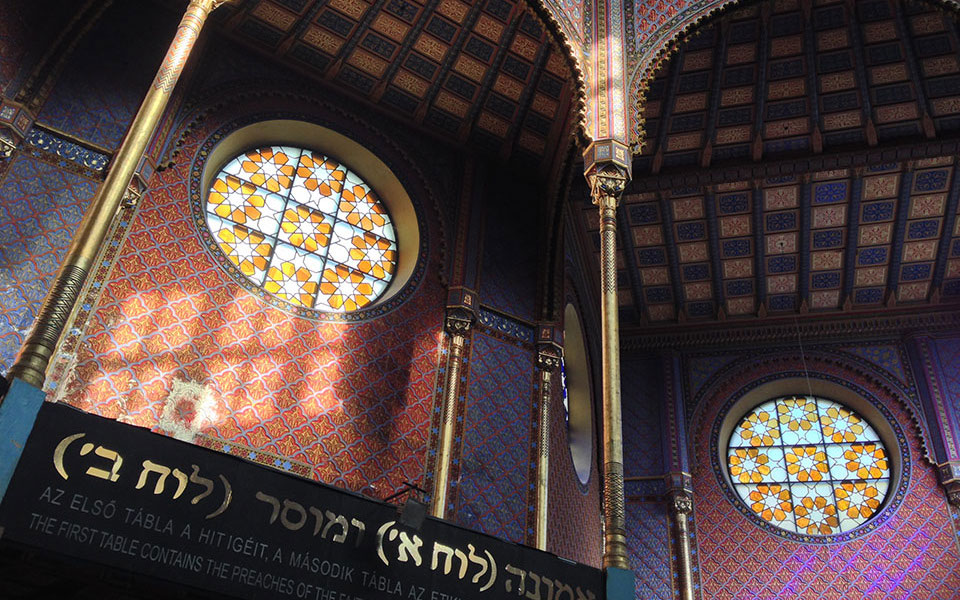Virág Judit Gallery has been one of the most successful galleries and auction houses in Budapest since its opening in 1997. The gallery’s 48th auction was on December 13th, 2014 where 213 items were auctioned, including Hungarian paintings from the 19th and 20th centuries as well as Zsolnay ceramics . The event was a great success and the absolute highlight was the auctioning of Róbert Berény’s painting called Sleeping Lady with a Black Vase, sold for a hammer price of HUF 70 million (approx. €221 000). We asked Judit Virág, founder and owner of the Virág Judit Gallery about the early years of the gallery and how it developed, the audience in the 1990s and today, as well as about Budapest.
When and how did you start the Virág Judit Gallery?
The story of this gallery and auction house on Falk Miksa Street started 17 years ago. By that time, I had already developed all the know-how and contacts that I needed to open this gallery. So in 1997, we decided with my husband, who is a great businessman, to buy this space and open our own gallery. Then within the next six months, we also decided that the gallery should operate as an auction house as well.
 Judit Virág. Photo: Virág Judit Gallery
Judit Virág. Photo: Virág Judit Gallery
What is the profile of your gallery?
We focus on Hungarian paintings from the 19th and 20th centuries along with Zsolnay ceramics. We have three auctions every year in May, in October and in December at the Budapest Congress Center, where we usually present over 200 items. Before each auction, we also have a two-week preview show. We basically prepare for these auctions all year round. We also have free temporary exhibitions that we organize around different themes on a regular basis, and we also offer free-guided tours and free lectures and presentations held by the most acknowledged art historians.
Download our Free Budapest Guides to learn how you can make the most of your trip.
All of these exhibitions have been very successful, and some of them have been especially popular, such as the 121 Most Beautiful Hungarian Paintings and the 121 Most Beautiful Mednyánszky Paintings. Over the last 17 years, we’ve had about 60 exhibitions and we’ve just had our 48th auction.
What was the art trade like in Budapest when you started your auctions?
It was exactly around the change of the regime, when I started working in the art trade. Back then, it was a completely new field. It was also a niche on the market, so I was actually very lucky to be part of this. There was no framework whatsoever, so I had to create and develop a new set of rules as well as a completely new structure of auctions with all the details from creating catalogues to presenting items.
We used international benchmarks and when we had our first auction in 1998, I made sure that the whole setting was just the same as if it would have been in any established auction houses in London or in New York. So although at that time, some auctions had already been held in Budapest as well as in other cities, we basically created a model that all the other auction houses then started to follow.
 Auction at the Budapest Congress Center. Photo: Virág Judit Gallery
Auction at the Budapest Congress Center. Photo: Virág Judit Gallery
Who was your audience in the very beginning and has it changed over the years?
In the beginning, there were a lot more foreigners than Hungarians. It was because the prices were extremely low. Then as the prices were going up, a lot of these art dealers stopped coming to the auctions, but at the same time, more and more collectors became regulars clients. These clients included private collectors from abroad as well as various institutions, banks, and insurance companies.
The prices were still relatively low and so they could get great quality art works for a very good price. I give you an example: these collectors could get a Vilmos Perlott-Csaba painting from 1907, from the time when he was working in the same studio as Henri Matisse. There was actually not much difference between the works of these two artists from that period, however, a Matisse painting would have cost a lot more.
What was the highest price ever paid for a painting at your auction?
In December, 2012, we sold Tivadar Csontváry Kosztka’s painting called View of Trau in the Sunset for HUF 240 million (approx. €777 000).
Download our Free Budapest Guides to learn how you can make the most of your trip.
If you look at the last 25 years, do you see any changes in the way people in Budapest deal with the arts?
It’s a good question. There have been a lot of changes; people are a lot more in touch with the arts nowadays. Also, I think an indirect, and yet the most crucial result of our work, is the number of great exhibitions that have been realized over the years, not only at the auction houses and private galleries, but also at the National Gallery, in Pécs, or at the Museum of Fine Arts. The exhibitions on Ripple-Rónai, Vaszary, Ferenczy, Mednyánszky, The Eigth, The Fauves, the Czóbel exhibition in Szentendre, or the exhibition called Allegro Barbaro at the Musée d’Orsay showcasing Hungarian paintings – all these exhibitions could not have been realized without our work.
It was due to the activity and the work of these galleries and auctions houses that a lot of truly exceptional paintings were discovered in private collections, paintings that nobody had known about before. As a result, people became a lot more open to the arts in general. I think Hungarians love going to exhibitions and they love beautiful art works. When we had the exhibition on The 121 Most Beautiful Paintings, the queue was lining up until Szent István körút and we had over 10 000 people visiting the show.
I also think that there is a simple reason why people are so eager to learn about these art works: before the change of the regime, only certain trends were approved by the State. And those paintings that represented other trends outside of this circle were basically unknown to the public. And these were the paintings that the private galleries started to showcase. I think this is the very best of Hungarian painting; the most modern, the most interesting and the most progressive paintings are from the eras of Expressionism, Futurism, the period when The Eigth and the Fauvists were active.
 Róbert Berény (1887-1953): Sleeping Lady with a Black Vase, 1927-1928. Photo: Virág Judit Gallery
Róbert Berény (1887-1953): Sleeping Lady with a Black Vase, 1927-1928. Photo: Virág Judit Gallery
Falk Miksa Street is now referred to as the gallery street in Budapest. Could you tell us a little bit about how this image has developed during the years?
In the beginning of the 1990s, there was only one gallery on Falk Miksa Street called BÁV. Then by 1994, Nagyházi Gallery moved to Balaton Street, just around the corner. In the meantime, Blitz Gallery also opened, so these were the first galleries that appeared in this neighborhood. In the following years, almost all shops on this street were turned into a gallery or an antique shop. So between 1995 and 2000, practically every month, there was a grocery store, a carpentry shop or some other store that was closed down and then reopened as a gallery.
Was there any strategic concept behind this development?
I think it’s quite simple: people who want to buy works of art, want to get everything in one place instead of visiting several neighborhoods. So it actually made sense to open all these galleries in the same area of the city. And I think we also help each other because we all have something different to offer, so we are actually not competing with each other.
What was the condition of these paintings like when they surfaced?
They were in a better condition than many paintings that were sitting at the museums.
 János Vaszary (1867-1939): Concert at Viareggio, 1929. Photo: Virág Judit Gallery
János Vaszary (1867-1939): Concert at Viareggio, 1929. Photo: Virág Judit Gallery
Who is your favorite painter?
My absolute favorite Hungarian painter is László Mednyánszky. Then my international favorites are Carpaccio, Vlaminck, Derain, Kirchner, and Klimt.
If you could pick any painting that you could put on your wall, which one would it be?
I’ve never thought about this, but probably it would be a Picasso painting from his Blue Period.
What do you like about Budapest?
I think Budapest has changed a lot during the last years, but I also think that people in Budapest have changed, too. If you compare today’s Budapest with what it was like in the early 1990s, it’s quite amazing how many new cafés, bars, and restaurants there are with terraces and also a lot of new galleries and pop-up restaurants opened, too so in a sense, people have taken over the city, which also made them much more open-minded.
Download our Free Budapest Guides to learn how you can make the most of your trip.
My favorite area is Újlipótváros but I also like the neighborhoods around the Basilica and Miszáth Kálmán tér. Over the last years, the city has also become a very popular travel destination, which also shows that Budapest is now a more livable city. There are only two things that should be improved in the city: so far we’ve never seemed to know how to make a use of the banks of the Danube and how to integrate them with the rest of Budapest. Also, I really miss having a practical and efficient means of transportation on the Danube. It would be so much easier to take a boat from, let’s say, Óbuda back to the city center.
What are your favorite places in the city?
I love riding my bicycle on Margaret Island or in Csillaghegy or Római Fürdő. I live on the Buda side and it’s also full of great restaurants, such as Alessio on Pasaréti Way. On the Pest side, I love sitting on the terrace of Dunapark Café Restaurant by Szent István Park, especially in the spring.
ADDRESS 30 Falk Miksa Street, 1055 Budapest SHOW ON MAP
OPENING HOURS 10am–6pm Mon–Fri, 10am–1pm Sat, closed on Sunday
More info at viragjuditgaleria.hu
Related Experiences
Sweet & Coffeehouse Walk
3 hours 79 USD
Enjoy your coffee and cake at legendary coffeehouses, hidden cafés and hip coffee
shops.
LEARN MORE
Jewish Cuisine & Culture Walk
4 hours 110 USD
Learn about Jewish culture, history and all the delicious foods on this unique 4-hour
tour.
LEARN MORE
Ruin Pubs, Street Art & Cool Spots
3 hours 45 EUR
Explore street art, art galleries, ruin bars and more in Budapest’s Jewish district.







